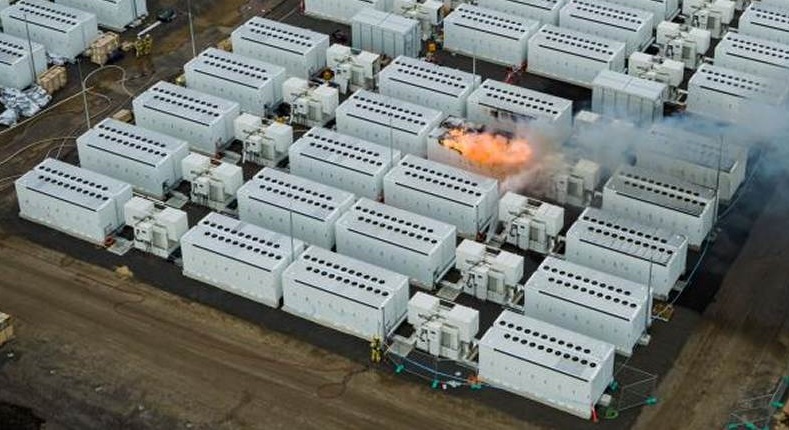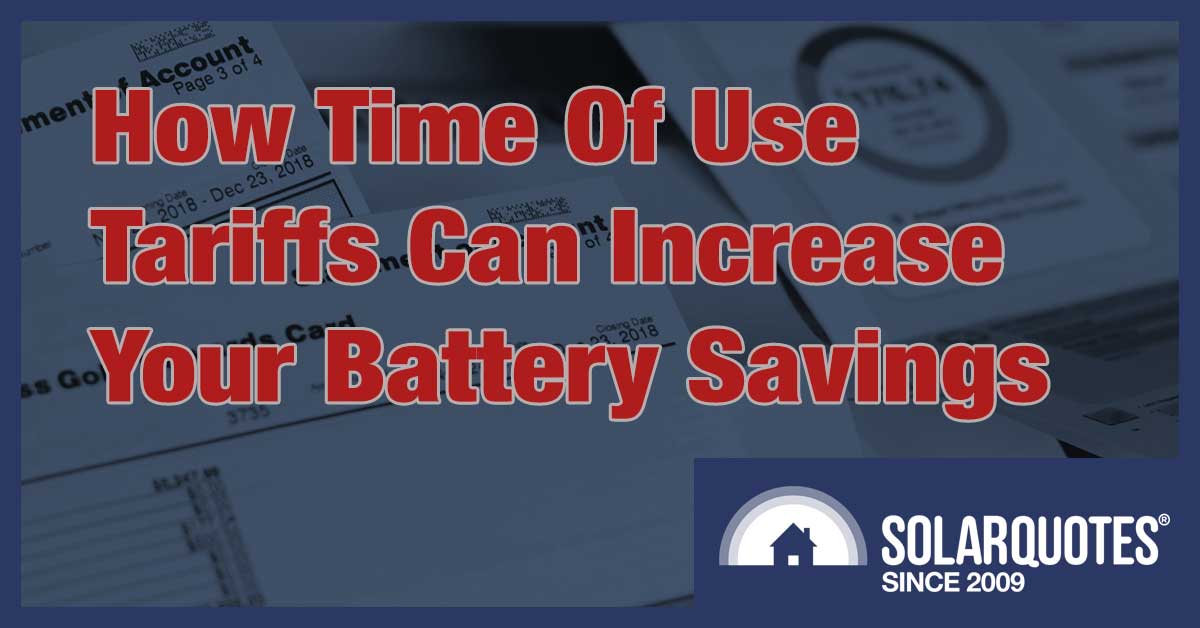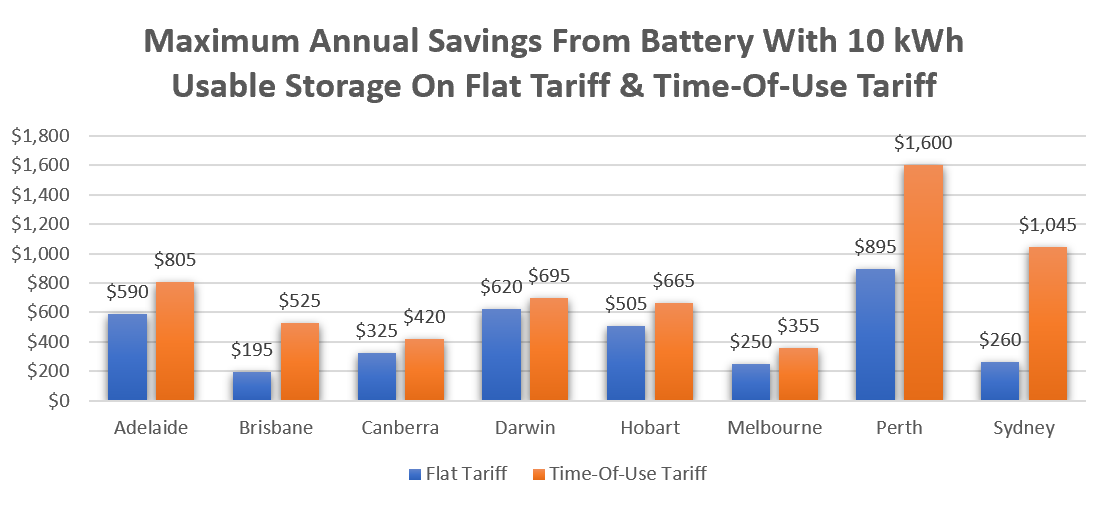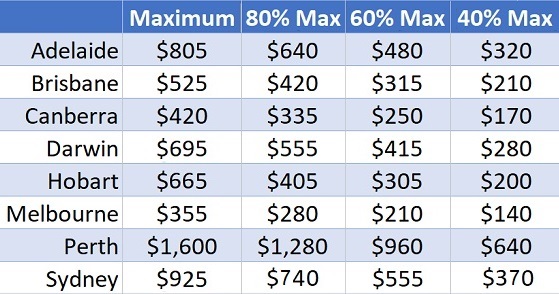I’ve been given a mission. It’s to determine how much money a home can save using a battery with a time-of-use tariff in every Australian capital.
This isn’t easy to do.
It’s not merely a matter of gathering information and crunching numbers. The hard part is presenting the results in a way that doesn’t make battery optimists cry.

“Who did this to you? Who hurt you so badly you feel the need to tell horrible lies about beautiful batteries?”
It’s very easy to tell people the maximum possible savings from a solar battery. The hard part is breaking the news to them they’ll never see that much benefit in real life. It can be tough for those who have fallen in love with the fantasy of an ideal battery. They don’t want to listen when you try to tell them that reality will sink its claws into their perfect numbers and drag them down to a far lower level.
But I feel obligated to let them know what they’re getting into. I used to be regularly whacked on the knuckles by a nun for fibbing, so I’m very honesty orientated. But I still feel terrible for tearing down people’s dreams.

Why she felt the need to whack my knuckles every time she told a fib, I’ll never know.
Fortunately, I have a solution. It’s called giving up.
I will give the maximum possible savings a home battery can provide in each capital and if optimists want to use those figures, I won’t get in their way. But, in the interests of realism and keeping my nun phobia at bay, I’ll also include information on why you’re unlikely to see those savings in real life.
I’ll begin by briefly covering the different tariffs and then determine the maximum possible savings. I’ll start with flat tariffs and then show the greater benefits from time-of-use tariffs.
Electricity Tariff Terminology
Here — in a nutshell — are the four main ways people pay for electricity:
- Flat tariff: Same charge for every kilowatt-hour of grid electricity.
- Time-of-use tariff: Charge per kilowatt-hour depends on time used. Can be based on seasons or time of day, but only time of day ones make sense for home batteries1.
- Demand Tariff: Low per kilowatt-hour charge but has a demand charge each month based on the maximum amount of power used during peak periods.
- Wholesale Price Exposure: This is an electricity plan where — in addition to other charges — the household pays the wholesale price for grid electricity when it’s used.
I’m only going to consider flat and time-of-use tariffs. The demand tariffs I’ve looked at so far are worse for solar battery households than time-of-use ones and can even be worse than a flat tariff.
Electricity plans that expose households to wholesale electricity prices have a lot of potential to lower bills, but to maximize the benefit requires a solar battery system smart enough to buy and sell on its own initiative and they’re not currently available.

During the war, Mr Peanut was shelled mercilessly.
Battery Assumptions
To work out the maximum possible savings from a home battery, I’ll have to decide its characteristics. I’ll make the following simple assumptions for my example battery:
- 10 kilowatt-hours of usable battery storage.
- Round trip efficiency of 90%.
- It’s fully charged with solar electricity every day.
- The household’s electricity consumption is high enough to be fully discharged during an evening Peak period, if there is one, every night.
For any remotely normal home, the last two assumptions are about as realistic as a cheese submarine, but for now, I’ll ignore that.
Flat Tariffs By Capital City
To work out the maximum possible battery savings I’ll need to know the cost of grid electricity and the solar feed-in tariff. To get these figures for flat tariffs2 I can use the SolarQuotes electricity plan comparison tool and choose what looks like the best plan from a large retailer for a home with a solar system of 10 kilowatts or less. Rounded to the nearest cent, the per kilowatt-hour amounts are:
- Adelaide: 34 cents, Feed-in 16 cents
- Brisbane: 22 cents, Feed-in 15 cents
- Canberra: 20 cents, Feed-in 10 cents
- Darwin: 27 cents, Feed-in 9 cents3
- Hobart: 25 cents, Feed-in 10 cents
- Melbourne: 18 cents, Feed-in 10 cents
- Perth: 29 cents, Feed-in 4 cents
- Sydney: 26 cents, Feed-in 17 cents

If you even slightly resemble this picture, you may be a battery optimist.
Determining Flat Tariff Savings
Using the above information for each capital it’s easy to determine the maximum possible savings using my example solar battery. All I have to do is:
- Determine how much the household saves in grid electricity by discharging the battery each night.
- Determine how much charging the battery with solar energy effectively costs the household every day.
- Subtract the cost from the savings to get the final result.
Starting with Adelaide and following the three steps, I get:
- Using 10 kilowatt-hours of battery energy at night instead of grid electricity will save $3.40
- With 90% efficiency you will need 11.1 kilowatt-hours to charge the battery, which costs $1.78 in forgone solar feed-in tariff.
- Subtracting the cost from the savings gives $1.62
Over a year this comes to $590.
Performing the same calculation for all capital cities gives:
- Adelaide: $590
- Brisbane: $195
- Canberra: $325
- Darwin: $620
- Hobart: $505
- Melbourne: $250
- Perth: $895
- Sydney: $260
As you can see, Perth comes out well ahead, thanks to their low feed-in tariff. Conversely, the least profitable place for a home battery on a flat tariff turns out to be Brisbane thanks to a low electricity price and high feed-in tariff.
Time-Of-Use Tariffs By Capital City
Determining the best time-of-use tariffs in each capital is more difficult, as the SolarQuotes retailer comparison page can’t handle them yet. For WA it was easy, since there’s only one available for Perth homes. For everywhere else I looked for the best available for a solar household. There may be better time-of-use plans than those I found, but the ones I used should be among the best.
Here’s the cost of a kilowatt-hour of electricity in cents for the different periods, plus the solar feed-in tariff:
- Adelaide: Peak 41c, Shoulder 25c, Off-peak 20c, Feed-in 13c
- Brisbane: Peak 30c, Shoulder 22c, Off-peak 18c, Feed-in 12c
- Canberra: Peak 26c, Off-peak 22c, Feed-in 12c
- Darwin: Peak 31c, Off-peak 24c, Feed-in 9c
- Hobart: Peak 30c, Off-peak 14c, Feed-in 7c
- Melbourne: Peak 25c, Off-peak 18c, Feed-in 12c
- Perth: Peak 56c, Shoulder 29c, Off-peak 15c, Feed-in 4c
- Sydney: Peak 53c, Shoulder 22c, Off-peak 14c, Feed-in 17c
A majority of the time-of-use plans have three different rates — Peak, Shoulder, and Off-peak — while a few only have Peak and Off-peak with no in-between Shoulder rate.
Update August 17th 2021: Hobart was originally missing from the above list because I couldn’t find a daily time-of-use tariff there, but AJ in the comments pointed one from Aurora out to me. This is fortunate because I had only found seasonal time-of-use tariffs and it requires a huge home battery to take advantage of them.

You’ll need to grab one of these if you want a home battery big enough to make use of a seasonal time-of-use tariff. Just take care to avoid any on fire, even if they come with a substantial discount.
Best Possible Time-Of-Use Savings
Determining the maximum possible savings from a time-of-use tariff is a little more difficult than with flat tariffs. This is because the Peak rate isn’t paid on weekends4. When there is a Peak period I’ll assume the solar battery will be completely discharged within it. On days without a peak period, I’ll assume the battery is fully discharged during the next most expensive period. This will be either a Shoulder or Off-peak rate depending on the plan.
Calculating the maximum possible savings using my example battery gives:
- Adelaide: $805
- Brisbane: $525
- Canberra: $420
- Darwin: $695
- Hobart: $665
- Melbourne: $355
- Perth: $1,600
- Sydney: $1,045
As you can see, Perth is way out ahead with a maximum battery saving of $1,600. This is due to having the highest peak and shoulder rates in the country and the lowest feed-in tariff.
Sydney is in second place with $1,045. But savings there were calculated slightly differently from other capitals. Because the Off-peak rate was lower than the solar feed-in tariff, I assumed the battery was fully charged with Off-peak grid electricity each day. If it’s instead charged with solar electricity, the annual savings will be $120 less and come to $925.
In last place is Melbourne thanks to its low Peak rate, while Canberra is second-worst.
Optimists Can Stop Reading Now
If all you want to know is the maximum possible savings from a home battery you can stop reading now. I will mention a few reasons why a home battery may not actually save that much money in real life, but if you’re not interested in reading things that aren’t 100% optimistic, there’s no reason to continue.
You can instead admire the battery posters on your walls, hug your pillow with the LG Chem RESU cover, and perhaps practice kissing using your framed photograph of a Tesla Powerwall 2 signed by Elon Musk.

Of course, even battery optimists can disagree on what they should be optimistic about.
5 Reasons Why You Won’t Get Maximum Savings Out Of A Battery
Are the home battery optimists gone? If so, I’ll provide some information they may not want to know. Here are five reasons why the maximum possible savings aren’t something you’ll get out of a battery in real life:
- There won’t always be enough surplus solar energy to fully charge a battery during the day.
- Normal households often won’t use all the stored energy during peak periods.
- Home batteries, with one exception, deteriorate in capacity with use.
- To determine savings you should compare how much you would pay on the best possible electricity plan without a solar battery and the best possible electricity plan with a battery. Just looking at what you would pay if you were on the best battery plan without a battery is misleading. This applies to the maximum possible savings I give in this article.
- In real life, solar batteries are unlikely to work as perfectly as they do in hypothetical examples. As a result, you have to expect some additional losses, inefficiencies, and downtime.
Just how much these problems will eat into savings is impossible to say, as they will vary between locations and from case to case. But it will come to a lot. Below I’ll give examples of two problems — fully charging with solar panels and fully discharging during Peak periods.
Full Battery Charging In Winter Is Difficult
Even if a home has a 10 kilowatt solar system, it often won’t be possible to fully charge a 10 kilowatt-hour battery in the middle of winter.
The graph below is the Solar Analytics information for an Adelaide home with 10.56 kilowatts of solar and an annual electricity consumption of around 6,000 kilowatt-hours, average for a four-person SA household.
If I assume the home self-consumes an average of 4 kilowatt-hours of solar energy during the day — which is a low amount — and then put a red arrow over every day in July the home doesn’t generate enough surplus solar energy to fully charge a home battery with 10 kilowatt-hours of usable storage, I get the following:

If this graph looks tiny to you because you’re on your phone, trust me, those red spots are bad.
In July, it shows that on 5 out of 31 days — about 16% of the days — the solar system did not generate enough surplus energy to fully charge a battery with 10 kilowatt-hours of usable storage and 90% round trip efficiency. So even with 10.56 kilowatts of rooftop solar, this household won’t always be able to fully charge a battery that size with solar energy.
If the household instead had 6.6 kilowatts of rooftop solar the situation would be much worse, with a shortfall on 11 out of 31 days.
The problem is worst in winter but can occur any time of the year solar energy generation is low and/or daytime electricity consumption is high. You can charge batteries with off-peak electricity instead of solar power, but in most cases this is more expensive. Of the electricity plans I used, only Sydney had a solar feed-in tariff is higher than the Off-peak electricity rate.
Low Electricity Consumption In Peak Periods
Most households usually use considerably less than 10 kilowatt-hours during peak periods. The typical amount varies between households and electricity plans, but is often under 7 kilowatt-hours. This reduces the maximum savings possible from a battery with 10 kilowatt-hours of usable storage because discharging outside of a peak period or not discharging at all reduces potential savings.
While low peak period consumption will sometimes reduce the problem of being unable to fully charge the battery with solar power, the two problems often occur at different times of year. Low household electricity consumption is most common in spring and autumn when little heating or cooling is required, while solar generation is worst in winter5.
The graph below shows the electricity consumption in April of an Adelaide household with annual electricity consumption of around 6,000 kilowatt-hours.
If we assume half the household’s electricity consumption occurs during the peak period on days there is one, then the home will only use all the energy in a battery with 10 kilowatt-hours of usable storage on days when electricity consumption is 20 kilowatt-hours or more. I have marked all the days in April this occurs with a red arrow:

If it’s hard to see this graph because you’re on your phone, this time the red dot is good.
While the 10.56 kilowatt solar system usually produces plenty of surplus energy in April, there is only a single day when peak period energy consumption will be high enough to make full use of 10 kilowatt-hours of usable storage.
Smaller Solar Batteries May Not Help
The smaller a home battery is, the easier it will be to fully charge with solar and fully discharge during peak periods. But this isn’t necessarily a cost-effective solution because smaller battery systems normally cost more per kilowatt-hour of usable storage. Also, a larger battery used at lower capacity will tend to deteriorate less rapidly. This makes it difficult to improve the economics of batteries by using one with a lower capacity.
VPPs Can Provide An Advantage
Some good news about batteries is Virtual Power Plants — VPPs for short — can improve their payback. But they also come with drawbacks, as every VPP involves sacrificing at least some control over the battery. Ideally, a VPP can provide substantial additional income.
Less ideally, they can potentially cause more wear and tear on your battery than the benefits are worth. While VPPs have plenty of potential, they also carry risk.
You can check what’s available in your area with our VPP Comparison Table.

Wait a minute… Why does this battery optimist have a gun on his wall?
A Simplistic Risk Assessment
I could do a lot of research and write around 40,000 words delving into details of determining exactly how much batteries will or won’t save you, but that sounds like hard work. Instead, I’m going to present one simple table that puts all the onus on you.
The table shows savings possible under four different conditions:
Maximum: This is the maximum possible savings the example battery that has 10 kilowatt-hours of usable storage and a 90% round trip efficiency can give. If you are foolishly optimistic or believe the benefits of a VPP will make up for any losses, feel free to use the savings in this column.
Optimistic — 80% Max: This is for people who like to look on the sunny side of things but aren’t so optimistic they don’t bother to buckle their seat belts. The savings here are simply 80% of the maximum.
Mediocre — 60% Max: For a middle-of-the-road approach, this gives savings 60% of the maximum.
Pessimistic — 40% Max: If you’re the sort of person who likes to err on the side of caution, you can use the results here, which are 40% of the maximum possible savings.
The results are annual savings. If you want a quick and dirty estimate of savings over 10 years — the maximum warranty length of most home batteries — add a zero to the end:
Perth Comes Out On Top
Perth is clearly the capital with the best return from a home battery. If you expect the return to be a mediocre 60% of the maximum, provided these two conditions are met…
- The battery lasts a few years beyond the end of its warranty
- You place at least some value on its ability to provide backup power
…Perth appears to be at least close to the point where batteries begin to pay for themselves.
But it’s not a sure thing. Firstly, circumstances will have to be considered on an individual basis. Don’t just pick a number off a table because it looks good. We also don’t know what will happen with electricity prices over the next 10 years. Personally, I expect them to head downwards as more batteries are installed along with more solar and wind capacity. But, despite this, things are looking good for Perth to lead the nation in home battery installations.
On the downside, home batteries face challenges in WA not seen in the rest of the country:
- Homes with rooftop solar over 6.66 kilowatts can’t receive a solar feed-in tariff, so almost all systems are under this size. While Perth has the highest solar output of any Australian capital, there are still likely to be many days when it’s not possible to fully charge a battery with solar energy.
- I only know of one VPP operating in WA and zero I can recommend. This means they are not an option for improving battery payback at this time.
- Solar households have been underpaid for the electricity they provide to the grid and the difference used to subsidise other generation in WA. The state may attempt something similar with home batteries, which will reduce their benefit to households.
Note I used the current feed-in tariff for new solar installations in WA of around 4 cents per kilowatt-hour. If you’re receiving the old feed-in tariff of 7.1 cents, the return from a battery will be around 8% less than the figures in the table above. With a 7.1 cent feed-in tariff, the annual savings for the different conditions will be:
- Maximum: $1,475
- Optimistic (80% Max): $1,180
- Mediocre (60% Max): $885
- Pessimistic (40% Max): $590
Although there are drawbacks, I am optimistic about batteries in WA. Because I think solar battery prices will fall, a home battery boom looks set to occur in the western third of the country.
A Rough Guide Only
The table of potential savings for a home battery with 10 kilowatt-hours of usable storage is not meant to be any kind of accurate guide to how much you’re likely to save from a battery. But it does make one thing clear. There’s a wide range of savings people can claim a solar battery provides without actually fibbing. A battery with 10 kilowatt-hours of usable storage could technically provide the maximum savings and potentially more with a good VPP. But it’s no fib when I say you should be prepared for a far less than optimal outcome.
Footnotes
- No battery is suitable for storing energy between seasons. The solution in Australia is to install more solar and wind capacity — as well as use existing hydro capacity — to ensure there is enough generation year round and use battery storage to fill in short term gaps. ↩
- Note flat tariffs may become unavailable to homes with smart meters in some parts, such as South Australia and Queensland. I disapprove of this, because making electricity bills more confusing is the sort of thing that gives grannies heart attacks. ↩
- You may be able to get a better feed-in tariff from Rimfire in the NT, so I’d check what they offer. ↩
- Some plans may also not have a peak rate on public holidays. ↩
- Except in the far north, because they’re weird. ↩




 RSS - Posts
RSS - Posts



Hi Ron,
Kim here – we have exchanged msgs before.
Am in Perth and as I have an EV, am on the EV tariff (20 cents between 11pm to 4 am; 29 cents at all other times).
Also I have a battery – but that is a different story.
“This is because the Peak rate isn’t paid on weekends4”
Victoria has just moved to a 7 day ToU which means peak is 3pm to 9pm on weekends.
Or was this modelled on the old 5 day ToU plans?
The plan I used had the peak on weekdays only and I recently looked it up, so they’re still available.
Hi Ronald,
I think battery prices falling sometime soon is a myth. However if the energy suppliers start charging us for exporting solar as has been mooted then I think a lot of us will install batteries just to spite them.
I have been disappointed how home batteries failed to fall in price over the past couple of years. But battery cells have fallen in price a long way, so expect competition will eventually get around to lowering prices. I’ll eat my hat if decent quality home battery systems don’t fall significantly in price. I just can be certain when it will happen. (Note: I have a chocolate hat set aside for occasions when I happen to be wrong. Also note, I’m not a thin person, so I may have been wrong more than once in the past.)
I’ve noticed home batteries seem to be fairly static (no pun intended) in price. But EV batteries have continued to reduce. When it looked like my EV battery was at risk of spontaneously exploding, the replacement cost of the 64kWh battery was $15,000-18,000. So why do domestic batteries cost so much? Any ideas?
I touched on this towards the end of my last write up of Canberra Battery Test Centre results:
https://www.solarquotes.com.au/blog/battery-test-centre-reports/
Basically, as far as I can see, it’s really difficult to make reliable home batteries. Even a massive company like LG Chem with vast amounts of engineering talent has had a hard time. So the way I see it, manufacturers are keeping home battery prices high to pay for recalls and repairs while those that are producing reliable batteries are happy to rake in the profits from high prices.
The good news is, there is plenty of room for prices to fall.
Hi Ron and Tony, actually LG chem resu batteries were amongst the cheapest when I had my two installed. I steered away from the overprice powerwall 2. I managed to get more storage kw with l.g. for a cheaper price than any other battery manufacturer. I’ve had my two l.g. batteries since 2017 and never, ever had a problem, they do their job perfectly. On the other hand I also have a powerwall 1 which was installed in 2016, this one had issues, like cooling fan stopped working so battery shuts down, till the whole battery was replaced (twice), installers had a hard time installing software, and in general im sitting on the wall with the powerwall (also the physical size of the unit is 4 times as large as the LG (comparable to the same k.w.)
Ronald,
You have not mentioned Zenaji batteries. They have a high life count & 20 yrs guarantee.
I currently have 4 of their batteries & will upgrade to 6. Not really an economic decision as you say (we are early adopters). We basically offset our peak TOU with the battery.
I think the reason battery costs have not fallen is due to the semiconductor shortage. The fire in China abt 2 years ago has affected many electronic devices, including cars (many cars have gone back to Analogue instruments & the costs have risen on ICE cars, & only EVs have reduced ion price!)
I moved to a TOU tariff abt 2 years ago. It saved me abt $80/quarter on thew previous fixed tariff.The battery will increase this saving marginally.
regards, Doug
My hypothetical yardstick would be take the flat rate by capital, multiply that by my average purchased electricity, then multiply that by 5-10 years. If I don’t save money on the battery then it’s not worth thinking about.
More realistically however, and as the July days image shows, there will be days where you simply don’t produce enough energy to recharge the battery Worse this could be on consecutive days! Thus you may want to having enough storage for a couple of days of bad weather which drops the payoff point even further away.
Hi George, you fail to realise that you can force charge your batteries on “off peak rate” during the hours of 10pm and 7am if you see that your batteries are not reaching fully charging during winter. I have successfully done away with my energy bills and get a chunky credit every 1/4. You will need to consider the plan your on and then go about fine tuning your energy use, and have newish appliances with a good energy rating, then bend the rules to your advantage. I have been doing this successfully since 2017. I’m on a time of use rate from energy australia, I also receive a 31% discount if pay on time, which obviously if you have a credit you don’t need to pay. Whatever credit I have every 1/4 is further discounted by another 31%. I estimate around Sept. Oct. next year (2022) my investment of $30,000 would be paid off. (around 5 1/2 years since installation date). A lot of people are lazy and think, I will install a massive solar system and big battery storage and whalla, I’m done. This is wrong. I keep a very close eye on my system and the weather and constantly having to adapt during different times of the year. SSSSHHHHHHH I better stop talking before more people get on board and the energy suppliers change the rules.
A “simple” calculation of average daily savings from a battery are made from these values:
– Ti: the average import tariff
– Te: export tariff
– C: the useable capacity of the battery
– U: the expected average daily capacity utilisation
– E: the round trip efficiency
The Avg Daily Saving = (Ti – Te/E) x C x U
So for instance if the average import tariff is 25c/kWh, FIT 8c/kWh, the useable capacity 10kWh, the average daily capacity utilisation 65% and round trip efficiency 90%, then
ADS = ($0.25 – $0.08/0.90) x 10 x 0.65 = $1.05
Ti is easy to calculate with flat rates, with TOU rates you need to make an estimate of the mix of peak/shoulder/off-peak imports the battery offsets and use a weighted average. Obviously just using the peak rate is over stating it.
Useable capacity (C) is a straightforward battery spec.
Expected average daily capacity utilisation (U) will typically be in the 50% to 70% range for batteries in the 10-13kWh range. Average capacity utilisation is where many are overly optimistic. I surveyed a dozen Powerwall 2 owners and their average capacity utilisation was 60%.
Round trip efficiency varies but is going to be close enough to 90% for most lithium chemistry batteries. Flow batteries are much lower.
I also built my own battery simulation model using my 5-min interval data. It can simulate batteries of different specs, but here’s an image of the battery state of charge for a simulated Powerwall 2 over the past ~1000 days if it were servicing our home with our 11kW solar PV system:
https://i.imgur.com/mWvsufx.png
What we can see is in Winter there are long periods where it’s a struggle to fully charge the battery with high consumption (heat pump heating), while in Spring (and part of Autumn) we wouldn’t fully discharge it (great production but no ned for heating/cooling).
It turns out our capacity utilisation would be 66%, a little above average for the Powerwall 2 owners I surveyed.
Daily savings estimate over past 12 months, using the best tariff plans (Essential Energy zone NSW) with and without a battery amount to $1.13/day (up from my long term average of $0.97/day due to FIT reductions) and a payback of 35 years.
I have been advised that from now on the feed in rate in Vic for Tango energy is 6.7c.
This seems to be what all retailers are moving to now.
Mandated minimum, and most common, is now 6.7c
See https://www.esc.vic.gov.au/electricity-and-gas/electricity-and-gas-tariffs-and-benchmarks/minimum-feed-tariff#toc–feed-in-tariffs-from-1-july-2021-to-30-june-2022
Hi Ron, I am interested to see how you go with the battery and electric vehicle. With my (rough) calculations, when you plug in your electric vehicle, your battery will be empty in no time at all which will not leave you any battery charge to run the house. Am I correct in saying this or am I missing something ??
I have a 2004 Hyundai Getz — so, as you can see, I am a man of taste and refinement. Finn has two EVs in his household and leaves one plugged into his charger. Because his charger can be set to only supply power when there is surplus solar his home battery will charge first in the morning and when its full the plugged in EV will be charged. Of course, there can be times he’ll want to charge quickly and this may drain the home battery. I recommend avoiding this if possible, but it’s no disaster when it occurs.
Hi Ron, you can not go get an accurate picture of how efficient (or inefficient) solar storage batteries have on offer. There is way too many variables at play to be able to work out an accurate pictures. You can draw all the graphs in the world, I can promise you, you will not be able to get an accurate picture.
As you already know, I have been a big fan of battery storage from day one, and an early adopter of a largish solar system. Without going into too much detail, (as I have already posted details before, and your probably sick of me), I am still on track to have my initial outlay of $30,000 to be paid off in 5-51/2 years from initial installation date. Let me explain. Before any solar / battery system installation, I paid about $1,000 per 1/4 for electricity. I now receive a CREDIT from my electricity supplier in the vicinity of $480.00 per 1/4 (and about $300 in the winter 1/4) Therefore I am saving $4,000 p.a. and I also supply electricity to a tenant of mine which I charge him about $1,000 p.a. SO, SO FAR I’M SAVING ABOUT $5,000 p.a. from before having a solar / battery system. ALSO INCLUDE MY CREDIT THAT I RECEIVE EVERY 1/4 (about $1,650 p.a.) THIS GIVES ME A REALISTIC SAVING OF ABOUT $6,650 p.a. X 5 years = $33,250.
By the way, I make it look simple, BUT it’s not. I had to get on the right tariff / plan, get a smaller hot water system, force charge the solar batteries when there is going to be cloudy / rainy days ahead on off peak rate.
I’ve got the latest appliances (for example my heat pump drier is 8 star energy saving), the fridge has inverter technology, and I have installed 3 separate split air conditioners in individual rooms. (I do have a monster ducted air conditioner that cost me $15,500 but has only come on twice since installing the individual split a/c units.
So, here’s my opinion, if you want to stop paying electricity.
1. Install the biggest solar system you can fit on your roof.
2. Get on a plan that suits your system. (you can bend the rules on time of use to your advantage with battery storage, and make sure you receive a feed in tariff for your excess power, (very important)).
3. Install solar batteries (make sure you only buy as many k.w. as you can use in a 24 hour period). Don’t go buying 30 k.w. of battery storage if you only use 5k.w. in a 24 hour period.
4. Make sure all your appliances / lights are relatively new and look at the energy consumption.
5. Make use of your solar system to heat up your hot water system. For example, when my batteries are full from the sun (about 11.00a.m), I switch on the hot water system and heats up from excess solar production, Whalla. If the weather is going to be cloudy, I’ll flip the switch back to “off peak” and the hot water system heats up at night. But 95% of the time, it’s heated up from solar.
For your interest my system consists of:
system 1: 5 k.w. solar system with a powerwall 1 battery. (6.5 k.w. storage)
system 2: 5.4 k.w. solar system with two L.G. batteries (16.5 k.w. storage)
cost: $30,000
I have three phase power, so on the phase that doesn’t have any solar attached to it, I only have the led lights connected to this phase.
The other two phases have the solar / batteries hooked up to them.
Hope this helps someone make an informed decision.
I am an investor and will not throw my money into something that doesn’t work or pay a dividend back.
“I am an investor and will not throw my money into something that doesn’t work or pay a dividend back.”
“I do have a monster ducted air conditioner that cost me $15,500 but has only come on twice since installing the individual split a/c units.”
The above are incompatible statements.
You’d have achieved a much better return by adding more PV rather than spending the money on the battery. Blended returns just hide how bad battery economics are.
There is however one way to help the financials of a battery – and it applies in a specific user case.
A part-pensioner with some savings can increase their pension by reducing their assessable assets. Legitimate means of reducing eligible assets include money spent on home improvements such as adding a home battery (the home itself is exempt). e.g. $10k spent on a battery will increase their pension by $780/year. Then add in the $300-400/year the battery might save on bills and well that can bring the battery’s return to almost bearable levels.
Hi Alex, I hear what your saying, but the big air conditioner was installed because the original one needed replacing, without too much thought at the time, we went for a system similar to the original one. Once my solar batteries were installed and I saw how much power the ducted air cond. was chewing up, I immediately had 3 split systems installed in individual rooms, (I installed them, so they only cost me $1,650.00 all up. and your absolutely correct about blended returns, that’s why I will always stay by my statement of saying that no one can paint an accurate picture, there is way too many variables at play.
I try to simplify my statements, by giving figures of what I used to pay for power and what I am paying now. I can go into extremely fine detail of how my systems are set up and how I run my household, but it would take a massive write up. If you don’t agree with anything I say, then don’t pay attention to it and go about your business of paying your electricity supplier. I’m extremely inquisitive and a tinkerer, I have set up my system to benefit me not the energy supplier, I also have fine tuned every aspect of energy usage in my household, from lighting, electrical appliances, h.w.s. etc. and YES i am an investor, and that’s why I have been a self funded retiree since I was 40 years old and live a very comfortable live off investment property rents.
SA Power Networks has an optional residential trial tariff on offer to retailers that should enable retailer to develop favourable retail offers for battery users. Network tariff RTOU+. It has the same supply charge as all other residential network tariffs, but rather than the flat 13.46 c/kWh (plus GST), the price varies from 2.01 c/kWh (plus GST) during the solar sponge (10am to 3pm), 11.17 c/kWh (plus GST) for all other times except solar peak and a very high Summer peak charge of 43.07 c/kWh (plus GST for the 5pm-9pm period from 1 November to 31 March.
It depends on how retailers choose to offer this in a retail offer (or not) but it will suit those who can avoid the summer 5pm-9pm window eg with a battery. It can also enable a battery to be charged or topped up from the grid during the solar sponge at a low price (the tariff will also suit those customers with other storage/flexible uses eg EV.s, swimming pools, hot water and underfloor heating).
Some retailers are offering this trial tariff paired with a flat energy price, others have a strong seasonal TOU energy price (which will further reward those customers who can use a battery between 5pm and 9pm throughout the year. They will get the benefit of low prices at other times, and will avoid the high prices from 5pm to 9pm via the battery). The Trial only started on 1 July, so retailer offers are slowly starting to emerge. Of course, the SA residential customer will need an interval meter to be able to access such offers.
One rather glaring misinformation in the article was “recharging exclusively with off peak power”. The current supplier originating in NSW regularly switches the off peak supply off and on at will during the core hours of 10.00 p.m. & 7.00 a.m. This is obvious from looking at the graph supplied on my account details. An ersatz “T.O.U.” regime.
Hi Chris
That sounds like a controlled load. If it was during the off-peak period on a time-of-use tariff the home would be blacked out, which would give you good cause to get angry.
What may be happening is the device on your controlled load is switching itself on and off. A hot water system will do this as it will stop drawing power when the water is hot and switch on again once it cools down.
Hi Chris, Ron is correct in saying that it’s the control load that is being switched on and off. NOT OFF PEAK. “Of peak” relates to the time you use electricity. so between the hours of 10 pm and 7 am any electricity used is charged at your off peak rate (mine is about 15c per kilowatt hour). Control load (usually for hot water systems) is switched on by the supplier between the hours of 11 pm and 7 am and heats up your hot water system. Once your hot water system is hot, your hws thermastat will switch off your hws element(s) till next time again. NOW if you have a spa bath and want to heat up your water and run the spa, you could (theoretically, bend the rules a bit) get an electrician to run a wire from your control load supply to your spa bath and do most of the heating and filtering during the night (when control load kicks in) which is the cheapest charged electricity. so instead of just heating up your hws, your also heating / filtering your spa bath. so when you need to use your spa the next day, it’s already hot from control load rate, it keeps costs down.
Not sure connecting a spa heater to a system already supplying power to a hot water system would be wise.
Most switched controlled loads have a 25A connection limit.
A 3.6kW element HW system is already 15-16A leaving less than 10A for a spa heater. Most spa heaters will need a much beefier supply than 10A.
Hi Alex, the reason I say about the spa as an example is because I successfully had this set up. I had the spa set up on a timer to come on about 2.00am so I can stager the load. So hws would come on at 11pm, by 1am the hws would be hot enough and would switch off. Then the spa would come on. I never had any issue in this set up. This mind you was before we had our large solar / battery system installed. It would be a different story if I had a spa now. I would switch on the spa when my solar batteries would be full from solar production and heat up the spa water from solar production. See, you need to adapt to your circumstances.
It is also noteworthy that for ToU on Ausgrid in NSW, April-May and Sept-Oct do not have peak hours at all – shoulder is the highest rate.
That worsens the equation further, although those are probably the months of lowest demand and minimal heating or cooling use.
Useful analysis, thanks.
Hobart does actually have a time of use tariff, so I am wondering if you could include Hobart in the calculations.
Peak tariff is 29.85
Off peak is 13.9
Thanks. Who is that with?
Thank you!
Update: All updated!
Hi Ron
It’s with Aurora Energy, Tariff 93:
https://www.auroraenergy.com.au/residential/products/residential-all-prices
Keep up the good work!
AJ
We use the grid as a virtual battery. Here are the stats for my 13.2kW/10kW PV system in the year up to 28/02/21:
– generated 10,893 kWh
– exported 9,261 kWh
– self-used 1,632 kWh
– imported from grid 3,125 kWh
The FiT during that time was $0.21/kWh and the import rate was $0.28369/kWh, so there was about a 7c difference. So, if generation was 35% more than imports we’d break even, cost-wise.
As you can see generation was 350% more so we were way in front on cost. Indeed, we saved $2,947 compared to having no PVs!
The FiT and import costs are different now. However, I see no point in having a home battery at this stage. I’m looking forward to V2G technology in the next couple of years at which time we’ll buy a suitable EV and it’ll become our home battery. 🙂
I have just checked my “riple control system” and it’s actually 40 amps. It’s got an Energy Australia sticker on it.
Love this latest report, SA gets lots of mentions, TOU discussed:
https://assets.bbhub.io/professional/sites/24/BNEF-Schneider-Electric-Realizing-the-Potential-of-Customer-Sited-Solar_FINAL.pdf
Perhaps I am missing something, but isn’t this ignoring the savings of using off-peak electricity from the grid (e.g. overnight), which is not constrained by the battery?
Our case: added a battery and switched to an EV in 2017 — and changed to time-off-use plan to take advantage of load shifting.
Pre-solar bills were about $3000 p.a. for domestic electricity; charging the car at the same rate would have added about $1000 (petrol was about $2500). Switching to a TOU plan (and VPP) our bills are now about $500 per year, including charging the car.
The combined saving of solar panels, battery and EV is almost $5000 p.a. so we recovered the cost of the battery in about three years.
After reading about some of these “profitable” installations, I’m interested in the tax implications of surplus (& possibly any) solar generation. In the 1990s the ATO published a view that solar generation was more of a hobby & income from such systems was trivial.
I suspect that is changing & the ATO will turn its attention to income generated by solar production, especially VPPs.
Does anyone know what is happening in this area?
If the ATO were to tax income from solar, they would have to make the systems tax deductible. If they didn’t worry about people on the early schemes receiving 50c per kWh I doubt that they would bother about current rates.
As for VPP we get $45 per quarter, so probably not enough to trouble the ATO — I don’t know if other companies offer more. As more storage is added to the grid supply and demand will be easier to balance so the value of such schemes will reduce. My guess is that electric cars will provide the solution, possibly we will be offered cheap charging in return for the suppliers being able to control the flow.
I was thinking more of the savings people like Tim E are talking about above (in excess of $6,500/year). Even though it is described as a credit against electricity costs, it can be thought of as income in a sense. Especially when capital outlays to produce the income have been paid off.
Has SolarQuotes looked at this at any stage?